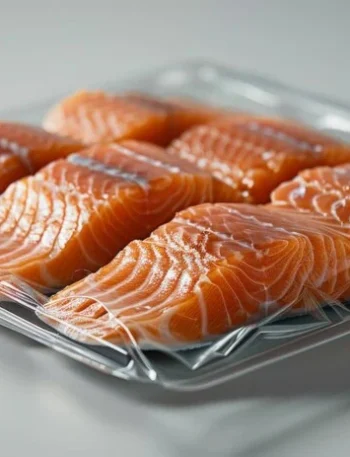General Description
The Atlantic salmon (Salmo salar) is a large, migratory fish native to the North Atlantic Ocean and its rivers. Known for its sleek, silver body with a blue or greenish tint, it typically weighs between 8-12 pounds but can grow larger in the wild, reaching over 3 feet long and living up to 6 years. Atlantic salmon are anadromous.
The range of Atlantic salmon spans the North Atlantic, from North America to Europe. As they prepare to spawn, Atlantic salmon undergo significant physical changes. Their body color often darkens, and they develop a pronounced hook, or “kype,” in the males, which makes their jaws more curved. Atlantic salmon grow relatively quickly compared to other fish species, especially in the ocean. The Atlantic salmon (Salmo salar), named by Carl Linnaeus in 1758, derives from Latin, where salmo means “salmon” and salar refers to “leaper.” This reflects the fish’s ability to leap over obstacles during migration.
Fast Facts
- Scientific Name
Salmo salar
- Size
28-30 inches (length), 8-12 pounds (weight)
- Lifespan
Up to 6 years
- Range
Found in waters around Iceland, Greenland, Canada, and Norway
- Diet
Feeds on smaller fish, crustaceans, and plankton
- Migration Type
Anadromous (hatch in freshwater, migrate to sea, return to spawn)
- Predators
bald eagles, ospreys, bears, seals, larger fish species, and humans
- Naming
Named by Carl Linnaeus in 1758; salmo means “salmon,” and salar means “leaper”
- Other Name
Black Salmon, Landlocked Salmon (Ouananiche), Bay Salmon
About the Species
Taste
Atlantic salmon has a rich, buttery flavor with a tender, flaky texture. Its mild taste allows it to absorb marinades and seasonings easily, making it versatile for various cooking methods. The high-fat content contributes to its moistness and enhances its flavor, making it a popular choice for both casual and gourmet dishes.
Health Benefits
Atlantic salmon is rich in omega-3 fatty acids, high-quality protein, and essential vitamins and minerals, promoting heart health and reducing inflammation. Regular consumption can aid in weight management and support overall bodily functions.
Nutrition Facts
Include a brief breakdown of its nutritional content per serving (3.5 oz):
- Calories: 206
- Protein: 22g
- Fat: 13g (mostly healthy unsaturated fat)
- Vitamins and Minerals: High in Vitamin D, B vitamins, and Selenium
Classification and name origin
Atlantic salmon (Salmo salar) belongs to the family Salmonidae and the order Salmoniformes. It is classified within the genus Salmo, which includes other salmon and trout species. The species name “salar” is derived from Latin, meaning “leaper,” reflecting the fish’s ability to jump obstacles during migration. It was first named by Carl Linnaeus in 1758.
Life History/Biology

Atlantic salmon undergo complex life stages that include hatching in freshwater, migrating to the ocean, and returning to rivers to spawn. They begin their life as eggs in gravel nests (redds) and hatch into alevins, which later develop into fry and then parr as they grow in freshwater. After about 1-3 years, they transform into smolts and migrate to the ocean, where they mature for 1-3 years before returning to freshwater to spawn.
During spawning, males develop a distinctive hook-shaped jaw (kype) and change color. After spawning, many adults die, but some may survive and return to the ocean, showcasing their iteroparous nature. Atlantic salmon are characterized by their high adaptability to various environments, including freshwater and marine habitats.
Availability
Atlantic salmon are available year-round in fresh, frozen, and canned forms. Most of the salmon in markets is farmed, primarily from Norway, Chile, and Scotland, due to declining wild populations.
Is Sockeye Salmon Sustainable?
Atlantic salmon is not considered fully sustainable in the wild due to overfishing and habitat loss. However, farmed Atlantic salmon is widely available and can be a more sustainable option when responsibly managed. Eco-friendly farming methods are essential for reducing the environmental impact of aquaculture.
Related Species
- Coho
- Sockeye
- Pink
- Chinook
- Chum
FAQs
What is Atlantic Salmon and why is it so popular?
It is a favored fish known for its rich flavor and tender texture. It’s popular because it’s versatile in cooking, packed with omega-3 fatty acids, and has a mild taste that pairs well with various dishes.
Is Atlantic Salmon healthy to eat?
Absolutely! Atlantic Salmon is loaded with healthy fats, high-quality protein, and essential vitamins and minerals. It’s great for heart health and can be a delicious part of a balanced diet.






You can really taste the quality in Atlantic salmon.
It’s the perfect fish for any style of cooking.
I always keep Atlantic salmon in my freezer for quick meals.